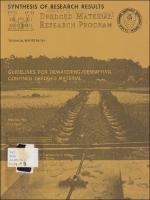Please use this identifier to cite or link to this item:
https://hdl.handle.net/11681/47593| Title: | Guidelines for dewatering/densifying confined dredged material |
| Authors: | Haliburton, T. Allan |
| Keywords: | Dredging spoil Dredged material Dredging--Research Dewatering Soil consolidation |
| Publisher: | U.S. Army Engineer Waterways Experiment Station |
| Series/Report no.: | Technical Report (Dredged Material Research Program (U.S.)) ; no. DS-78-11 |
| Abstract: | Primary emphasis of Task 5A research was oriented toward dewatering fine-grained dredged material resulting from maintenance operations and placed in confined disposal areas. Based on results of research, as synthesized herein, it was determined that: a.) Use of progressive surface trenching concepts to remove disposal evaporative dewatering of fine-grained dredged material is the most cost-effective dewatering alternative. The net dewatering and dredged material reclamation produced from use of surface trenching concepts will depend on existing climatic conditions, channel sediment/dredged material engineering properties, and whether or not an aggressive and continuous sur-face trenching dewatering program is conducted. The most effective method of trench dewatering requires that a 1-ft or greater surface crust be developed in the disposal area as rapidly as possible to support- conventional matted drag-line equipment in further operations. Trenching with a vehicle developed for the Navy for travel in a riverine environment, the Riverine Utility Craft, was found to be the optimum method for obtaining this necessary crust thickness with minimum time and cost. b.) When existing constraints make it impossible to implement a surface trenching dewatering program, a surface trenching pro-gram alone will not produce dewatering at necessary rates, or it is desired to obtain maximum possible dewatering effects, various concepts of either gravity- or vacuum-assisted under-drainage may be applied. Effective underdrainage systems must be installed prior to disposal, either in or on the original disposal area foundation or in the surface trenching network developed during dewatering of a previously placed lift. Underdrainage dewatering may.be cost-effective when pervious disposal area foundations are present or a nearby supply of suitable pervious material is available from previous dredging and disposal operations. c.) Implementation of any program of fine-grained dredged material dewatering and densification will be conducted most effectively as part of an overall confined disposal area management plan. Operation and management concepts are presented which, if implemented before, during, and/or after disposal, should result in enhanced dredged material dewatering. The concepts include thin lift placement; site clearing, grubbing, and leveling prior to disposal; optimized use of coarse-grained material available from dredging; subdivision of large disposal sites into smaller subareas and site operation on a series or parallel subarea basis; movement of dredged material inflow points during the disposal operation; and improvement of site access during construction. The main technical unknown in application of concepts synthesized in the report is the exact rate at which dewatering will occur. State-of-the-art prediction methods given and referenced in the report are satisfactory for feasibility determinations, and, in many instances, use in final design. |
| Description: | Technical Report |
| Gov't Doc #: | Technical Report DS-78-11 |
| Rights: | Approved for Public Release; Distribution is Unlimited |
| URI: | https://hdl.handle.net/11681/47593 |
| Appears in Collections: | Technical Report |
Files in This Item:
| File | Description | Size | Format | |
|---|---|---|---|---|
| Technical Report DS-78-11.pdf | 10.06 MB | Adobe PDF |  View/Open |